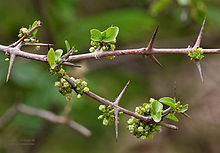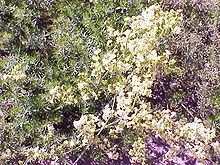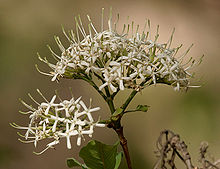- Rubiaceae
-
Rubiaceae 
Luculia gratissima Scientific classification Kingdom: Plantae (unranked): Angiosperms (unranked): Eudicots (unranked): Asterids Order: Gentianales Family: Rubiaceae
Juss.Type genus Rubia
L.Subfamilies - Cinchonoideae
- Ixoroideae
- Rubioideae
The Rubiaceae is a family of flowering plants, variously called the coffee family, madder family, or bedstraw family. The group contains many commonly known plants, including the economically important coffee (Coffea), quinine (Cinchona), and gambier (Uncaria), and the horticulturally valuable madder (Rubia), west indian jasmine (Ixora), partridgeberry (Mitchella), Morinda, Gardenia, and Pentas.
Members of the coffee family tend to be concentrated in warmer and tropical climates around the world. Currently, there are about 611 genera and more than 13,000 species in the Rubiaceae.[1] This makes it the fourth largest family of flowering plants by number of species, and fifth largest by number of genera.
Contents
Etymology
The family takes its name from the madder genus Rubia, which derives from the latin word "ruber", meaning "red".[2] The family was described by Antoine Laurent de Jussieu in 1789. The well-known genus Rubus (blackberries and raspberries) is unrelated and is part of the Rosaceae family.
Distribution
Although Rubiaceae are found in nearly every major region of the world (with the exception of continental Antarctica, the high arctic, and portions of central Africa and Asia), diversity is highest in the humid tropics. The pattern of diversity in the family is very similar to the global distribution of plant diversity overall.[3]
The greatest number of species occurs in Colombia, Venezuela and New Guinea. When adjusted for area, Venezuela is the most diverse, followed by Colombia and Cuba.[3] A large number of poorly studied species exist as understorey shrubs in Madagascar and are threatened with habitat destruction.[4]
Taxonomy
A number of traditionally accepted families (Dialypetalanthaceae, Henriqueziaceae, Naucleaceae, and Theligonaceae) are now incorporated within Rubiaceae following molecular phylogenetic research by the Angiosperm Phylogeny Group.
Rubiaceae Rubioideae
Ixoroideae
Cinchonoideae
Coptosapelteae
Relationship the three subfamilies of the Rubiaceae, together with the tribe Coptosapelteae and the genus Luculia; the placement of these two groups relative to the three subfamilies has not been fully resolved.[5] According to the World Rubiaceae checklist, 611 genera and 13,143 species were currently accepted as of 2009.[3] Three subfamilies (Rubioideae, Cinchonoideae and Ixoroideae) and over 43 tribes are recognised. Elmar Robbrecht and Jean-François Manen have proposed that only two subfamilies be recognised, an expanded Cinchonoideae (which includes the Ixoroideae, Coptosapelta and Luculia) and the Rubioideae.[6]
Psychotria, with 1834 species, is the largest genus within the family, and the third-largest genus of angiosperm, behind the legume Astragalus and the orchid Bulbophyllum. Twenty-nine other genera also have more than 100 species. On the other hand, 211 genera are monotypic; together they account for more than a third of all genera in the Rubiaceae, but fewer than 1% of all species.[5]
With many large and poorly defined genera, the family has not been as extensively researched as many other of the large flowering plant families.[4]
History
Rubiaceae were "classically" divided into two subfamilies, the Coffeoideae, which had placentas with just a single ovule, and the Cinchonoideae, which had more than one ovule per placenta. However, as early as 1893 Hans Solereder identified this system as artificial, since individuals with a single species of Tarenna had placentas with one or more than one ovule. During the twentieth century other characteristics were used to delineate subfamilies including the distribution of raphides, the absence of endosperm or heterostyly. On this basis, three, five or eight subfamilies were recognised. In 1988 Elmar Robbrecht divided the Rubiaceae into four subfamilies, the Ixoroideae, Cinchonoideae, Antirheoideae and Rubioideae. While the limits of the Rubioideae remained almost unchanged in the face of molecular studies, the Antirheoideae was shown to be polyphyletic, while the Ixoroideae was broadened and the Cinchonoideae narrowed.[6]
Subfamilies
The genera are arranged in tribes, and these placed in one of three recognized subfamilies. One tribe, the Coptosapelteae, and one genus, Luculia, have not been placed within a subfamily and are sister to the rest of Rubiaceae.[5]
- Cinchonoideae
- Chiococceae
- Cinchoneae
- Guettardeae
- Hamelieae
- Hymenodicteyeae
- Hillieae
- Isertieae
- Naucleeae
- Rondeletieae
- Ixoroideae
- Alberteae
- Bertiereae
- Coffeeae
- Condamineeae
- Cremasporeae
- Gardenieae
- Ixoreae
- Mussaendeae
- Octotropideae
- Pavetteae
- Posoquerieae
- Retiniphylleae
- Sabiceeae
- Sipaneeae
- Vanguerieae
- Rubioideae
- Anthospermeae
- Argostemmateae
- Coussareeae
- Craterispermeae
- Danaideae
- Gaertnereae
- Knoxieae
- Lasiantheae
- Morindeae
- Ophiorrhizeae
- Paederieae
- Psychotrieae
- Putorieae
- Rubieae
- Schradereae
- Spermacoceae
- Theligoneae
- Urophylleae
Characteristics
Rubiaceae are an easily recognizable family characterized by opposite leaves that are simple and entire, with interpetiolar stipules, tubular sympetalous corollas and an inferior ovary. Exceptionally, there are some plants that have only a single leaf at each node, alternating from one side to the other. In these cases, the alternate leaf arrangement is produced through the suppression of one leaf at each node.[7] A wide variety of growth forms are present in the Rubiaceae. While shrubs are most common, members of the family can also be trees, lianas or herbs. The flowers, which are usually bisexual, have a 4–5 lobed calyx and generally a 4–5 lobed corolla, 4 or 5 stamens and two carpels.[7]
Evolution
The fossil history of Rubiaceae goes back at least as far as the Eocene. The geographic distribution of these fossils, coupled with the fact that they represent all three subfamilies, is indicative of an earlier origin for the family, probably in the Late Cretaceous or Paleocene. Although fossils dating back to the Cretaceous and Palaeocene have been referred to the family by various authors, none of these fossils have been confirmed as belonging to the Rubiaceae.[8]
The oldest confirmed fossils, which are of fruit that bear strong resemblance to the genus Emmenopterys were found in Washington State and are 48–49 million years old. A fossil infructescence and fruit found in 44-million-year-old strata in Oregon were assigned to Emmenopterys dilcheri, an extinct species. The next oldest fossils after these date to the Late Eocene and include Canthium from Australia, Faramea from Panama, Guettarda from New Caledonia, and Paleorubiaceophyllum, an extinct genus, from the southeastern United States.[8]
Fossil Rubiaceae are known from three regions in the Eocene (North America north of Mexico, Mexico-Central America-Caribbean, and Southeast Pacific-Asia). In the Oligocene they are found in these three regions and Africa. In the Miocene they are found in these four regions, South America, and Europe.[8]
Ecology
When the family is viewed as a whole, it is clear that the Rubiaceae are tolerant of a broad array of environmental conditions (soil types, altitudes, community structures, etc.), and not specialists for one specific habitat type (although often genera within the family are). The plants tend not to be eaten by the caterpillar larvae of butterflies, but some sphingids (Semanophorae) do appear to prefer them.[1] The genera Myrmecodia and Hydnophytum are interesting, as they are epiphytes that have evolved mutualistic relationships with ants.[9]
Uses
The most economically important member of the family, and the world's second most important commodity (after petroleum) are the two species of shrub Coffea canephora (also known as Coffea robusta) and Coffea arabica, used in the production of coffee.[3]
The bark of trees in the genus Cinchona is the source of a variety of alkaloids, the most familiar of which is quinine, one of the first agents effective in treating malaria. Woodruff (Galium odoratum) is a small herbaceous perennial that contains coumarin—a natural precursor of warfarin—and the South American plant Psychotria ipecacuanha is the source of the emetic ipecac.[4] Psychotria viridis is frequently used as a source of dimethyltryptamine in the preparation of ayahuasca, a psychoactive decoction.[10]
Originally from China, the common gardenia (Gardenia jasminoides) is a widely grown garden plant and flower in frost-free climates worldwide. Several other species from the genus are also seen in horticulture. The genus Ixora also contains plants seen cultivated in warmer climate gardens.[4] The New Zealand native Coprosma repens is a commonly used plant for hedges. The south African Rothmannia globosa is seen as a specimen tree in horticulture.
Rose madder, the crushed root of Rubia tinctorum, yields a red dye, and the tropical Morinda citrifolia yields a yellow dye.
Genera
- For a full list, see List of Rubiaceae genera
References
- ^ a b Stevens, P. F. (2001 onwards). Angiosperm Phylogeny Website. Version 9, June 2008. http://www.mobot.org/MOBOT/research/APweb/
- ^ Wiktionary. "Ruber". Searched November, 2011. http://en.wiktionary.org/wiki/ruber
- ^ a b c d Davis, Aaron P.; Rafaël Govaerts, Diane M. Bridson, Markus Ruhsam, Justin Moat, Neil A. Brummitt (2009). "A global assessment of distribution, diversity, endemism, and taxonomic effort in the Rubiaceae". Annals of the Missouri Botanical Garden 96 (1): 68–78. doi:10.3417/2006205.
- ^ a b c d Robbrecht, E. (2009). "Rubiaceae Research at the National Botanic Garden of Belgium". National Botanic Garden of Belgium website. National Botanic Garden of Belgium. http://www.br.fgov.be/RESEARCH/PROJECTS/rubiaceae.php. Retrieved 16 December 2009.
- ^ a b c Bremer, Birgitta (2009). "A review of molecular phylogenetic studies of Rubiaceae". Annals of the Missouri Botanical Garden 96 (1): 4–26. doi:10.3417/2006197.
- ^ a b Robbrecht, Elmar; Jean-François Manen (2006). "The major evolutionary lineages of the coffee family (Rubiaceae, angiosperms). Combined analysis (nDNA and cpDNA) to infer the position of Coptosapelta and Luculia, and supertree construction based on rbcL, rps16, trnL-trnF and atpB-rbcL data. A new classification in two subfamilies, Cinchonoideae and Rubioideae". Systematics and Geography of Plants 76: 85–145.
- ^ a b Takhtajan, Armen (2009). "Class Magnoliopsida (Dicotyledons)". Flowering Plants (Second ed.). Springer. pp. 51516. doi:10.1007/978-1-4020-9609-9. ISBN 978-1-4020-9608-2.
- ^ a b c Graham, Alan (2009). "Fossil record of the Rubiaceae". Annals of the Missouri Botanical Garden 96 (1): 90–108. doi:10.3417/2006165.
- ^ Kapitany, Atilla (2007). Australian Succulent Plants: An Introduction. Boronia, Victoria: Kapitany Concepts. pp. 144–55. ISBN 0-646-46381-0.
- ^ Riba, Jordi; Marta Valle, Gloria Urbano, Mercedes Yritia, Adelaida Morte, Manel J. Barbanoj (2003). "Human Pharmacology of Ayahuasca: Subjective and Cardiovascular Effects, Monoamine Metabolite Excretion, and Pharmacokinetics". Journal of Pharmacology and Experimental Therapeutics 306 (1): 73–83. doi:10.1124/jpet.103.049882. PMID 12660312.
External links
- Rubiaceae at The Plant List
- Rubiaceae, Dialypetalanthaceae, Henriquezaceae, Naucleaceae, Theligonaceae at The Families of Flowering Plants (DELTA)
- Rubiaceae at the Encyclopedia of Life
- Rubiaceae at the Angiosperm Phylogeny Website
- Rubiaceae at the online Flora of China
- Rubiaceae at the online Flora of Pakistan
- Rubiaceae at the online Flora of Zimbabwe
- Rubiaceae at the online Flora of Western Australia
- Rubiaceae at the online Flora of New Zealand
- Rubiaceae at Christian Puff's online Rubiaceae Flora of Thailand
- Rubiaceae at the Integrated Taxonomic Information System
- Rubiaceae at the USDA NRCS PLANTS database
- Rubiaceae Research at the National Botanic Garden of Belgium
- World Checklist of Rubiaceae at the Royal Botanic Gardens, Kew
Categories:- Asterid families
- Rubiaceae
- Cinchonoideae
Wikimedia Foundation. 2010.








